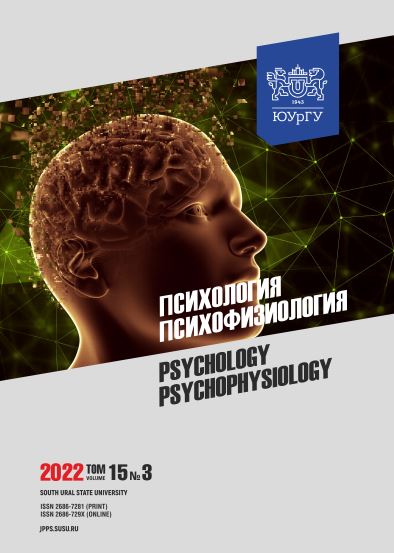Features of the development of spatial orientation in younger schoolchildren with mental retardation
Abstract
Background: Spatial orientation is among the most significant functions for successful schooling. Therefore, the identification of both the rate of development of spatial orientation and its features is a priority task for the development of effective correction programs and provision of psychological support to younger schoolchildren with special educational needs. Aims: the paper aims to identify the features of spatial orientation in younger schoolchildren with mental retardation. Materials and methods: Our cross-sectional study involved 25 children with mental retardation aged from 8 to 9 years and 25 children with normative development. The inclusion criterion (the main group) was the results of expert evaluation of children. The control group consisted of 2nd grade students who successfully coped with basic education program. The study was based on the data obtained with the Luria neuropsychological battery adapted by J. Glozman to identify the developmental features of coordinate, quasi-spatial, verbal-spatial and visual-spatial functions in children. Statistical methods included comparative analysis of the level of spatial orientation in younger schoolchildren with mental retardation and normative development (φ-Fisher test; Student's t-test; Pearson's correlation coefficient). Results: The data obtained allowed to identify differences in the rate of development of spatial orientation and its features in children with mental retardation and normative development. Conclusion: There was a statistically significant positive relationship between all parameters of the development of spatial functions, which confirmed the belonging of these functions to a single system, as well as a certain independence of verbal-spatial and visual-spatial functions in mental ontogenesis.
Downloads
References
2. Bulanova N.O. Actual problems of including children with intellectual disabilities in the educational process. Molodoy uchenuy = Young scientist. 2019;21(259):487–490 (in Russ.).
3. Strelkov V.I., Zavarzina O.O., Shmeleva S.V. et al. Psychological barriers in college teacher's “helping professions”. Research Journal of Pharmaceutical, Biological and Chemical Sciences. 2016;7(1):1938–1945.
4. Grebennikova V.M., Bonkalo T.I., Grebennikov O. et al. A study of personality factors in inclusive vocational education: the case of Russia. Espacios. 2019;40(44):25–27.
5. Koval V.A., Abdulganiev M.R. Problems of teaching children with mental retardation. Innovacionnaya nauka = Innovation Science. 2021;7:109–111. (in Russ.).
6. Kuzma L.P., Shumilova E.A. About organization of teaching for students with easy mental disability of different ages. Mir nauki, kul'tury, obrazovaniya. 2020;1(80):38–40. (in Russ.). DOI: https://doi.org/10.24411/1991-5497-2020-00015
7. Lakhtin A.Y. Shmeleva S.V., Gulyaev A.A. et al. Possibilities of logorhythmics in the development of preschoolers with mental retardation Biomedical and pharmacology Journal. 2019;12(2):931–938. DOI: https://dx.doi.org/10.13005/bpj/1719
8. Dunaeva I.A., Korobeinikov I.A. The main tasks and content of diagnostics in the working conditions of the PMPK. Vospitanie i obuchenie detei s narusheniyami razvitiya = Education and training of children with developmental disorders. 2007;4:60–64 (in Russ.).
9. Vidyaeva Yu.V., Pankova E.S. Overcoming specific difficulties in teaching younger schoolchildren aged 10–11 years with a mild degree of mental retardation in conditions of inclusive education. Molodoi uchenyi = Young scientist. 2019;46(284):257–262. (in Russ.).
10. Fotekova T.A. Dynamics of speech functions in schoolchildren with general underdevelopment of speech and mental retardation. Sibirskii psikhologicheskii zhurnal = Siberian Journal of Psychology. 2009;33:69–73 (in Russ.).
11. Krotkova O.A., Semenovich A.V. Some features of the brain organization of images of human visual memory and the mechanisms of the occurrence of confabulations. Psikhologicheskii zhurnal = Psychological journal. 1994;15(1):97–108. (in Russ.).
12. Leitner Y., Heldman D., Harel S. et al. Deficits in spatial orientation of children with intrauterine growth retardation. Brain Research Bulletin. 2005;67(1-2):13–18. DOI: https://doi.org/10.1016/j.brainresbull.2005.04.017
13. Nejati V., Moradkhani L., Suggate S. et al. The impact of visual-spatial abilities on theory of mind in children and adolescents with autism spectrum disorder Research in Developmental Disabilities. 2021;114:103960. DOI: https://doi.org/10.1016/j.ridd.2021.103960
14. Topychkanova T.N. Creation of conditions for the formation of spatial representations of preschool children with mental retardation. Molodoi uchenyi = Young scientist. 2021;8(350):55–60. (in Russ.).
15. Routh D.K., Schroeder S.R. A History of Psychological Theory and Research in Mental Retardation since World War II. International Review of Research in Mental Retardation. 2003;26:1–59. DOI: https://doi.org/10.1016/S0074-7750(03)01001-2
16. Filippova N.V., Barylnik Yu.B., Ismailova A.S. The modern view of mental retardation. Mezhdunarodnyi zhurnal prikladnykh i fundamental'nykh issledovanii = International journal of applied and fundamental research. 2015;10-2:256–262 (In Russ.).
17. Gorbataya E.V., Moshnyakova A.A. Neuropsychological approach to work with children with mental retardation. Molodoi uchenyi = Young scientist. 2021;11.1(353.1):52–54. (in Russ.).
18. Carlin M.T., Soraci S.A., Hobbs K.L. et al. Detection of Motion-defined Forms by Individuals with Mental Retardation and Autism: Evidence of Modifiability Intelligence. 1999;27-2:141–156. DOI: https://doi.org/10.1016/S0160-2896(99)00017-3
19. Fung W.K., Chung K.K.H., Lam C.B. Mathematics, executive functioning, and visual-spatial skills in Chinese kindergarten children: Examining the bidirectionality. Journal of experimental child psychology. 2020;199:104923. DOI: https://doi.org/10.1016/j.jecp.2020.104923
20. Petrarca M., Cappa P., Zanelli G. et al. Spatial rotational orientation ability in standing children with cerebral palsy. Gait and Posture. 2013;37(4):494–499. DOI: https://doi.org/10.1016/ j.gaitpost.2012.08.022
21. Glozman Zh.M. Neuropsychological approach to the development of thinking in childhood. Sovremennoe doshkol'noe obrazovanie. Teoriya i praktika = Preschool education today. Theory and practice. 2012;6:62–71 (in Russ.).
22. Akhutina T.V. Rusetskaya M.N., Gusarova Z.V. The problem of writing and reading disorders in children: data from the All-Russian survey. Specialnoe obrazovanie = Special Education. 2019;3(55):36–49. (in Russ.).
23. Adamos T., Adamos T., Chukoskie L., Townsend J. et al. Spatial attention in children with perinatal stroke. Behavioural Brain Research. 2022;417. DOI: https://doi.org/10.1016/j.bbr.2021.113614
References on translit
-Copyright (c) 2022 Psychology. Psychophysiology

This work is licensed under a Creative Commons Attribution-NonCommercial-NoDerivatives 4.0 International License.



